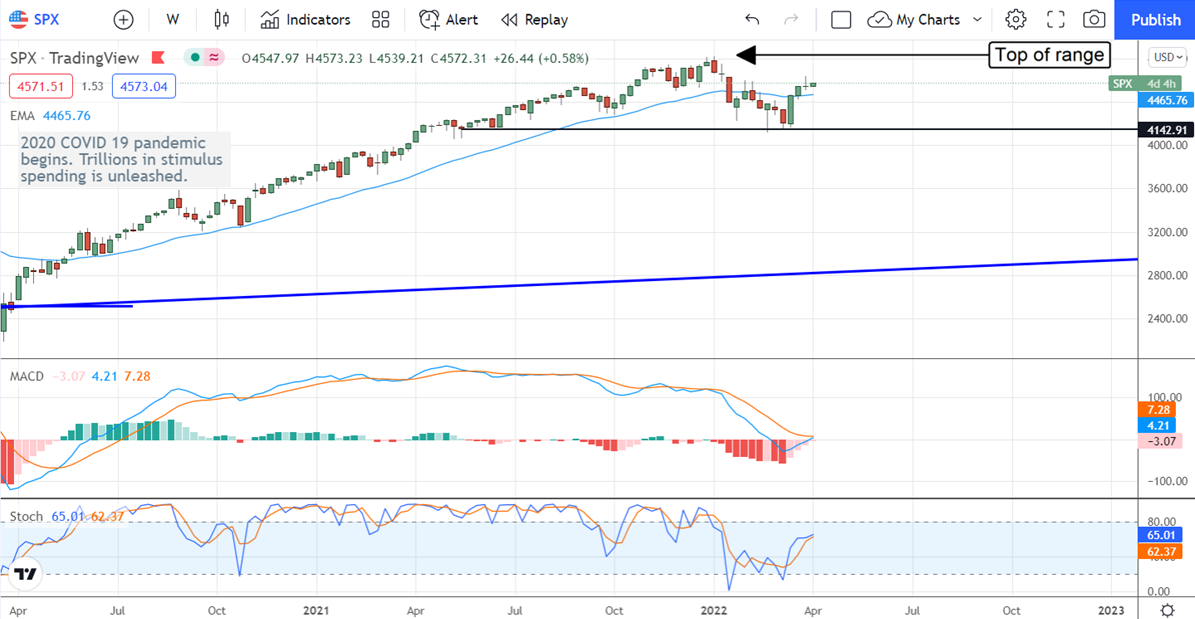There Is An Underlying Weakness In The Market
The Q1 S&P 500 earnings reporting season is set up for kick-off in about a week when JPMorgan Chase (NYSE:JPM) and some of the other big banks report their earnings.
While the data is promising, there is an underlying weakness within the market that we are very wary of. Inflation and supply chain hurdles are reportedly worsening in the wake of the Ukrainian invasion and high oil prices are the only evidence we really need to support that.
Oil via Energy Select Sector SPDR® Fund (NYSE:XLE), is a primary input cost on so many levels that it's mind-boggling to think how we could survive without the fuels, lubricants, resins, and organic chemicals we use to make just about everything on the planet.
The good news is that improvements and earnings growth acceleration are still expected for the back half of the year, the bad news is that near-term headwinds are stronger than previously expected and will likely keep the market in correction if not moving lower over the next couple of months.
The Outlook For Earnings Growth Is Faltering
The analysts are still expecting earnings growth for the S&P 500 and the consensus for Q1 growth has even edged higher over the last few weeks, but that is just about the end of the good news in regards to earnings expectations. While the consensus for Q1 is up over the past few weeks, it edged lower by a tenth two weeks before the start of the season and is mostly flat for the last several months.
The real takeaway is that almost all of the growth is due to a single sector, the energy sector. Right now, there are 7 sectors with declining earnings outlooks and 4 sectors expecting earnings decline while the energy sector is expected to post earnings growth of 165%.
Digging a little deeper, the consensus estimate for the energy sector has been on the rise in tandem with rising oil prices. The consensus as reported by Factset is up 8000 basis points over the past 3 months which is telling, because the consensus for the broad index has been flat in that time. While the expectations for energy sector earnings have been rising robustly, the outlook for just about every other sector is worse or worsening.
Looking forward, the consensus for Q2 is on the rise as well but that is also due primarily to the energy sector and that goes for the full-year consensus as well. The consensus for the calendar year 2022 is up over the past few weeks due to a 4000 basis point improvement in the energy sector outlook.
What We Are Expecting For The Q1 Reporting Cycle
We are expecting to see the energy sector outperform its consensus estimates and lead the market. What we are expecting to see from the rest of the index is the impacts of supply chain hurdles and inflation. The two may offset each other at the headline level, but may result in downward pressure to the index assuming revenue and/or earnings are weaker than expected.
The news that will drive the market, however, will be the outlook for Q2 and the year. Any negative pressure on the outlook for earnings will put pressure on the index and keep it capped, if not moving lower.
The Technical Outlook: Beware A Double-Top In The S&P 500
The near-term technical outlook for the S&P 500 is bullish, but we are leery of a top at the latest all-time high. Price action is well above the long-term primary trend established in 2009-2012 and ripe for consolidation or correction.
If the index moves up to the all-time high and confirms resistance at that level, a Double Top will be in play. Our best-case scenario is that the index will change its trend to sideways within the range of 4,100 to 4,700 until it meets back up with the primary trend line.
Our worst-case scenario, the scenario in which the outlook for earnings takes a big hit this reporting cycle, is the index will fall below 4,100 and correct back toward the trend line with a chance of hitting 2,800 or lower in the absolute worst case.

